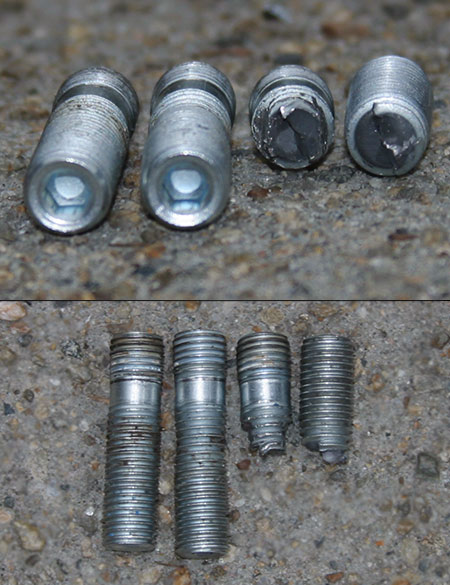
Just when you think the worst is over, something else happens. After two nights spent freeing my wheels from rust, Saturday I finally had the time to mount the new wheels, which I expected to now be an easy half-hour job. As I mentioned, during this process I also took the opportunity to change the wheel bolts to studs and lug nuts. When tightening down the last wheel using my torque wrench, two of the lugs would never get tight enough and seem to just keep going with only a medium amount of torque. and then…BANG! and some rust shavings fell to the ground. I thought I had stripped or even shattered my wheel hub. I removed the wheel to find everything seemingly OK. I pulled on the stud to see if it had stripped, when it came apart in my hands.
Now I was in trouble: the stud had snapped off with not much more than a nub sticking out from the rotor. I tried a pipe wrench, vice grips, and a number of things, but I just didn’t have enough surface area to get a grip on it to unscrew it out. I couldn’t put the wheel back on with a missing bolt..and I had a long drive that I was already rushing to leave for. I started contemplating my poor car getting dragged out on a flat bed when I started thinking out of the box. Finally, it came to me. I took my ever-useful Dremel and grinded down two sides of the bolt flat. Then I was able to get a grip on it with the vice grips and unscrew the bolt. It was one heck of a scare and proves yet again that even the easy jobs-like the 1-hour job of changing your seasonal wheels–can turn wrong in so many ways. And you can never have too many tools!
The metal inside the break looked especially soft. Then, I noticed that the other bolt in that wheel that wouldn’t tighten didn’t look like the other bolts: it was thin in the middle. It looks like there was a defect in the forging of these two bolts, resulting in a stretch in the middle that makes them slightly longer, thinner and weaker in the middle, and the threads are stretched and wider spaced. When the nut reached this section, it tried to squeeze those threads into their proper place, and the weaker center could not handle it and snapped. These were quality Gorilla-branded wheel studs and lug nuts but it proves you need to take a second to inspect things before you put them to use. Now I’m a little nervous about the rest of the studs and I might just return them all to the stock lug bolts. Click on the photo above to see a normal stud, the second faulty stud that has a thin center, and the two halves of the snapped stud.
If it were me, I’d pull all the studs (I’m a Murphy’s Law kinda guy….) and either go back to the factory bolts for now and take a poll on some hard-core racers and see what they use and replace again accordingly. I take it you weren’t over setting the torque on the wrench (if it is a click style).
I know of a few people that use Gorilla lugs on others cars without a problem, but if the visual problem you see is on more than one, then it is bound to be a batch problem across the board for that size. I would even write or email Gorilla as a customer safety followup concern too.
No need to take changes, especially when you need to re-torque the wheels at the next autocross!
Comment by Eddie — May 22, 2006 @ 1:01 pm
You could have used an Easy Out set up if you had known of them.
They work great as I had this problem with my Off Road car and old VW bolts many times. I always have a EO set up in my tool box.
Sorry to hear of your truble…..I’ll be sticking to the OEM’s thank you.
Comment by ltzmtor — May 22, 2006 @ 7:58 pm